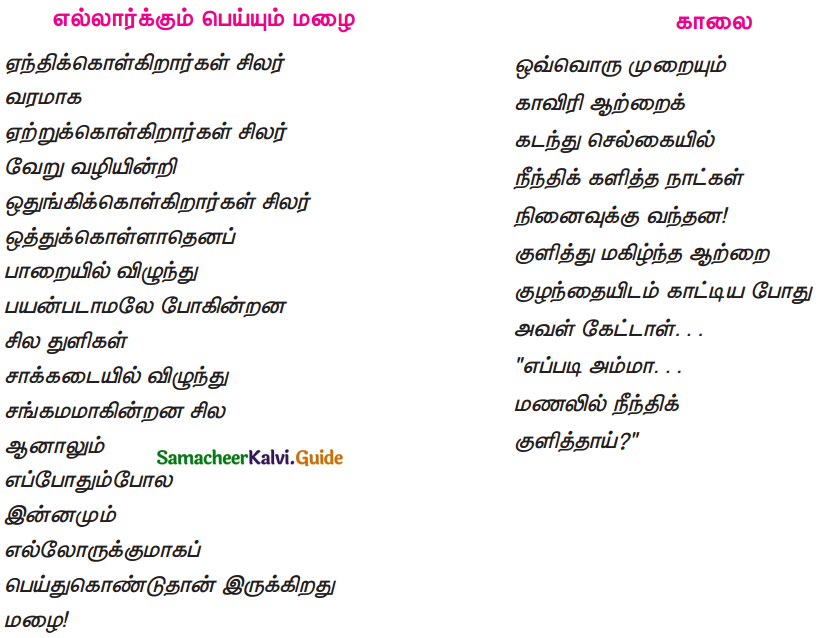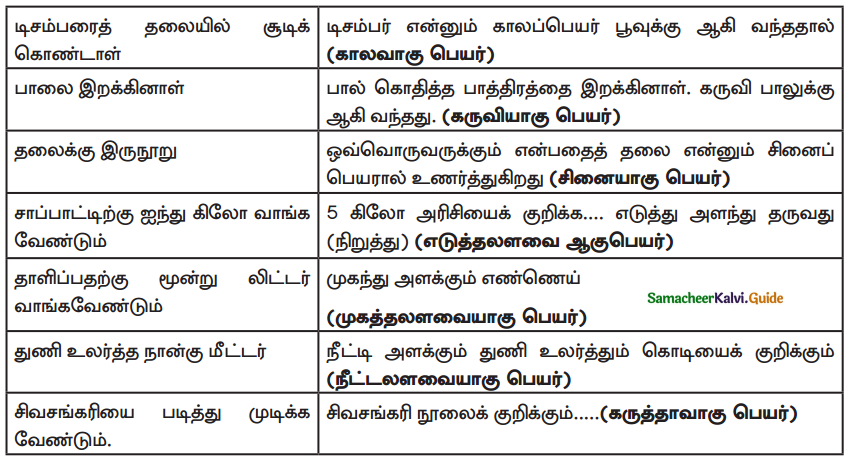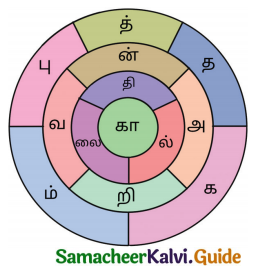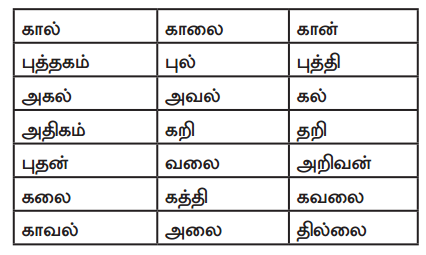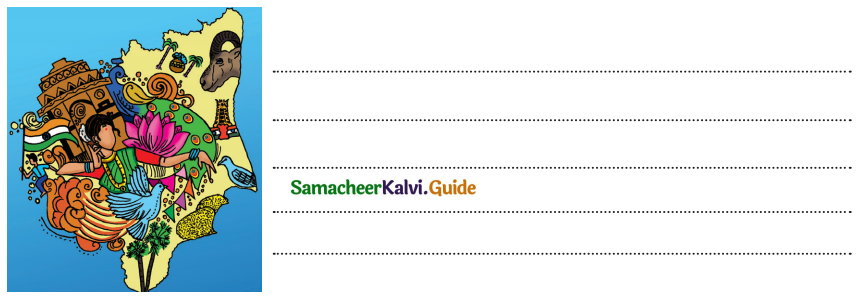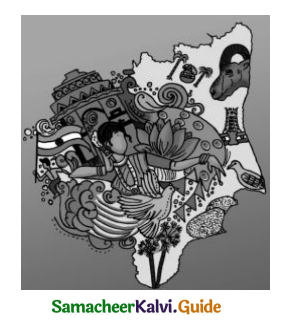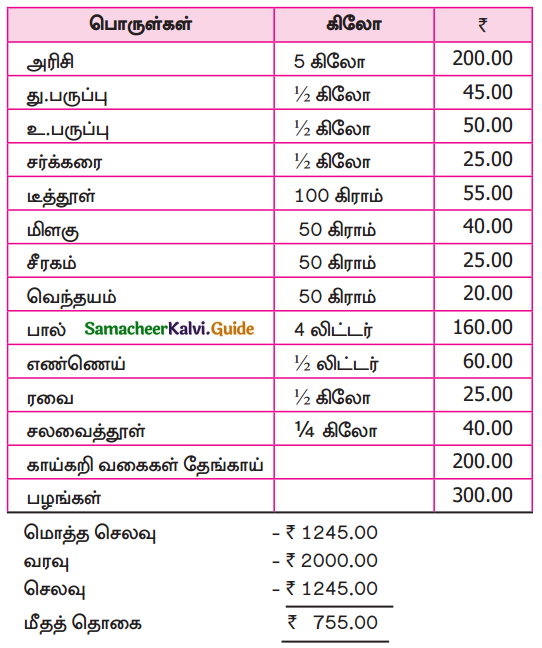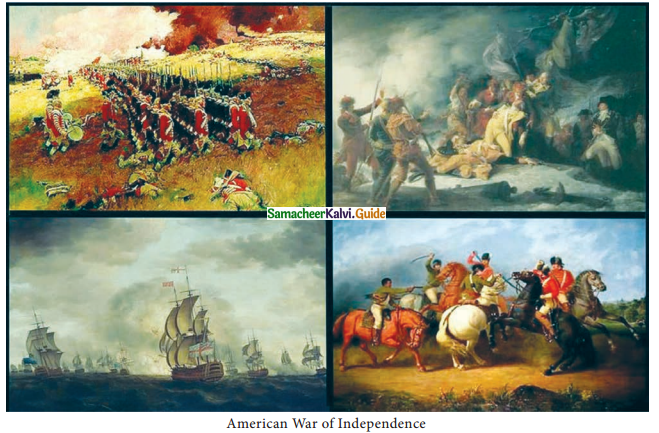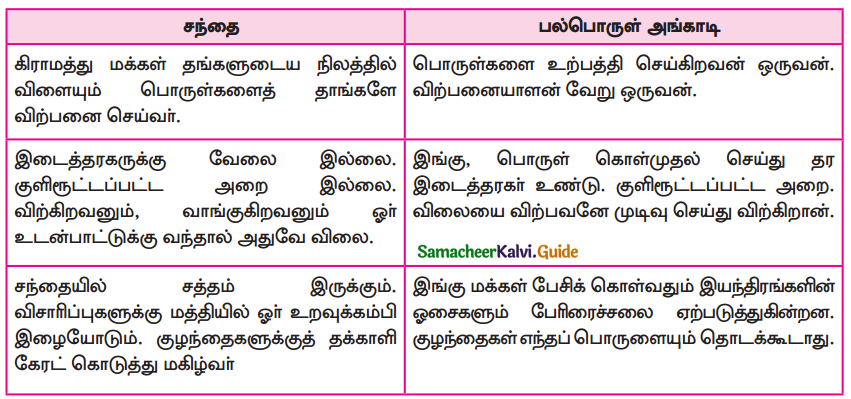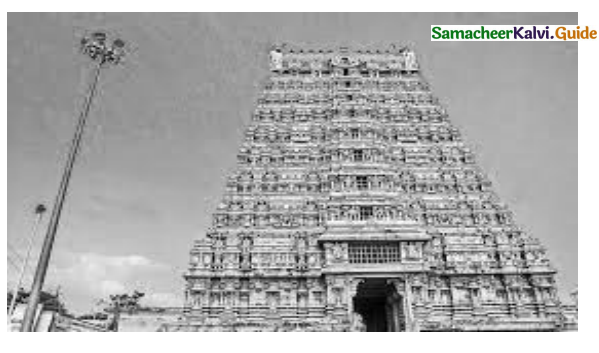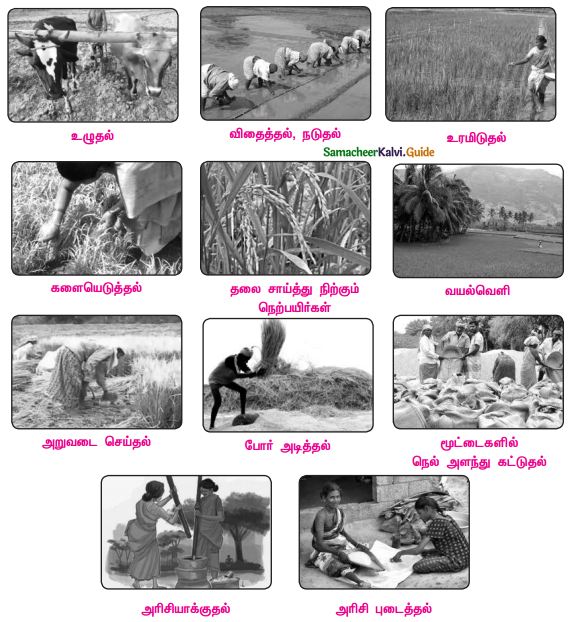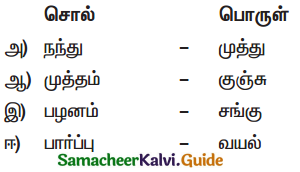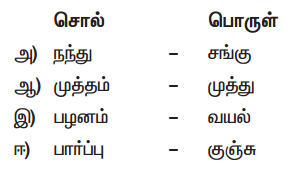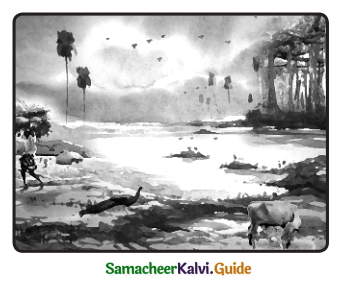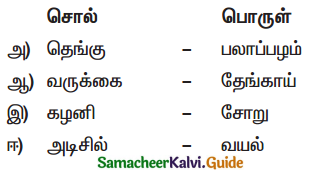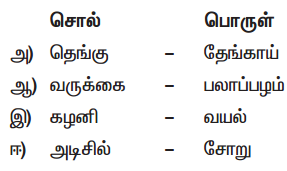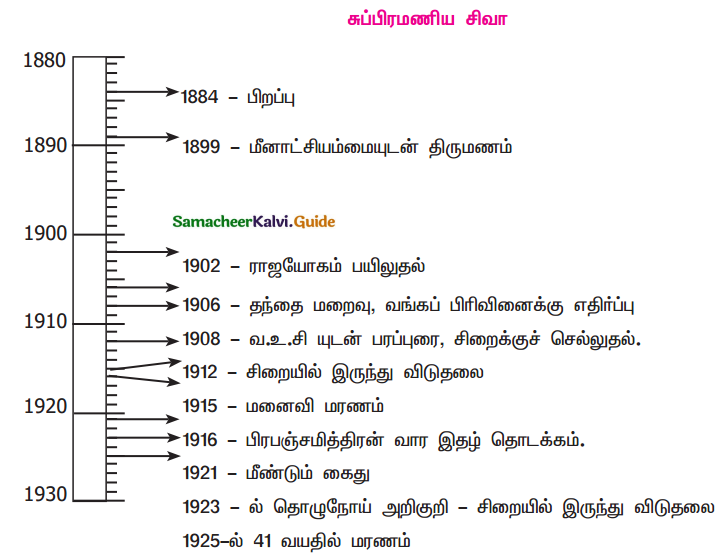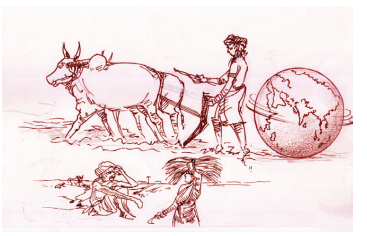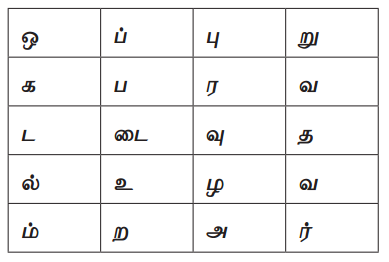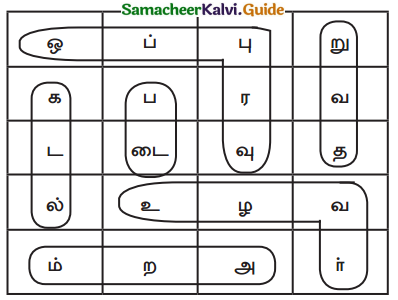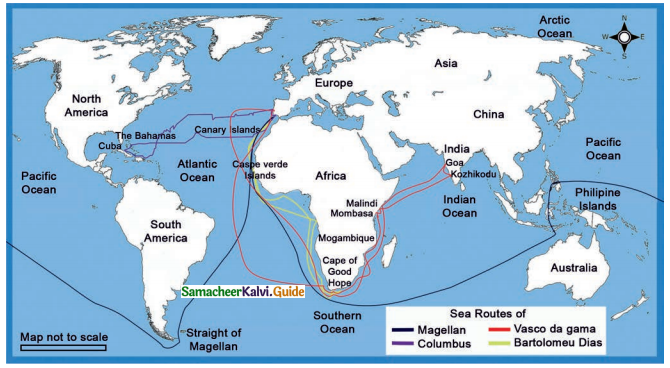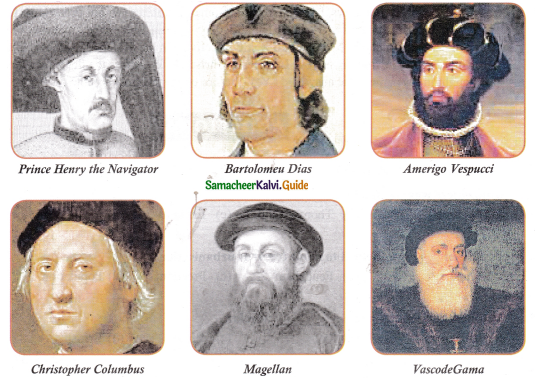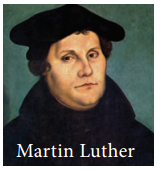Students can Download 9th Tamil Chapter 8.1 பெரியாரின் சிந்தனைகள் Questions and Answers, Summary, Notes, Samacheer Kalvi 9th Tamil Guide Pdf helps you to revise the complete Tamilnadu State Board New Syllabus, helps students complete homework assignments and to score high marks in board exams.
Tamilnadu Samacheer Kalvi 9th Tamil Solutions Chapter 8.1 பெரியாரின் சிந்தனைகள்
கற்பவை கற்றபின்
![]()
Question 1.
“இன்று பெரியார் இருந்திருந்தால்” என்னும் தலைப்பில் மேடைப் பேச்சுக்கான உரை ஒன்றை எழுதுக.
Answer:
அவையில் கூடியிருக்கும் அனைவருக்கும், முதற்கண் என் அன்பான வணக்கத்தைச் சமர்ப்பிக்கின்றேன்.
இன்று உங்கள் முன் இந்த மேடையில் நான் பேச எடுத்துக்கொண்ட தலைப்பு என்ன தெரியுமா? “இன்று பெரியார் இருந்திருந்தால்” என்பதே ஆகும்.
பகுத்தறிவுப் பகலவன், சுயமரியாதைச் சுடர், தெற்காசியாவின் சாக்ரடீசு, வைக்கம் வீரர், பெண்ணினப் போர் முரசு, ஈரோட்டுச்சிங்கம், புத்துலகத் தொலை நோக்காளர் என்றெல்லாம் புகழப்பட்டவர் தந்தை பெரியார்.
அடிமை இருளில் மூழ்கிக் கிடந்த தமிழ் சமுதாயத்திற்கு மட்டுமல்ல பாரத தேசத்திற்கே, புதிய வெளிச்சம் பாய்ச்சியவர் எனில் மிகையாகாது. புதிய விடியலுக்கு தன் கொள்கையால் பூபாளம் இசைத்தவர்.
![]()
சமூகம், மொழி, கல்வி, பண்பாடு, பொருளாதாரம் என அனைத்துத் துறைகளிலும் புதிய சிந்தனை ஏற்படுத்திய பெரியார், இன்று இருந்தால், இன்றைய சமூக பண்பாட்டுச் சீர்கேடுகள், இன்றும் கல்வியில் உள்ள வேறுபாடுகள், பொருளாதார சீர்கேடுகள், நாகரிகமற்ற அரசியல் செயல்பாடுகள், சாதியினால் நடைபெற்றுக் கொண்டிருக்கின்ற வீண் சண்டைகள், குழப்பங்கள், ஆணவக் கொலைகள், பெண்களுக்கு எதிராக நடைபெறும் குற்றச்செயல்கள் அனைத்தும் அந்தப் பகுத்தறிவு பகலவனை ஒளி குன்றச் செய்திருக்கும்.
![]()
கல்வியில், வேலைவாய்ப்பில் இடஒதுக்கீடு. பெண்களுக்கான இட ஒதுக்கீடு பெண்களுக்கான சொத்துரிமை, குடும்பநலத்திட்டம், கலப்புத் திருமணம், சீர்திருத்த திருமண சட்ட ஏற்பு என அவர் விதைத்த விதைகள் சில வேரூன்றி இருக்கின்றன. சில முளைக்காமலே போய்விட்டன. இந்த நிலையில் இன்று பெரியார் இருந்திருந்தால்,
“மீண்டும் ஒரு புரட்சி, மீண்டும் ஒரு மதுவிலக்கு, மீண்டும் ஒரு மொழிப் புரட்சி” எனப் புதிய புரட்சிகளால் புதிய விடியலை ஏற்படுத்தியிருப்பார்.
ஆனால், இன்று அவர் இல்லை, அவர் கொள்கைகளை உணர்ந்த நாம், அவர் காட்டிய வழியில் புதிய உலகம் செய்வோம். வேறுபாடற்ற சமத்துவ சமுதாயத்தை உருவாக்க முயல்வோம்.
சமுதாயம் மூடப்பழக்க வழக்கங்களில் இருந்து மீண்டெழ அரும்பாடுபட்ட அவரது பிள்ளைகளாகிய நாம் அச்செயலை புத்துணர்ச்சியுடன் செயல்படுத்துவோம். நன்றி! வணக்கம்!
![]()
Question 2.
பெரியாரை நேர்காணல் செய்வதாகக் கருதி வினாப்பட்டியலை உருவாக்குக!
Answer:
நேர்காணலுக்கான வினாக்கள்
- அய்யா! பகுத்தறிவு என்பதற்கு விளக்கம் தாருங்கள் அய்யா?
- மனிதர்களுக்காக மதங்களா? மதங்களுக்காக மனிதர்களா? தெளிவு படுத்துங்களேன்.
- சாதியினால் மனித வாழ்விற்குப் பயன் உண்டா?
- சாதியும் மதமும் மனித சமுதாயத்தை ஒற்றுமை படுத்துகிறதா? பிரித்து வைக்கிறதா?
- கல்வியில் ஏற்படுத்தப்பட வேண்டிய மாற்றங்களாகத் தாங்கள் கருதுபவை யாவை?
- எத்தகைய நூல்கள் நம் மொழியில் படைக்கப்பட வேண்டும் என்று விரும்புகிறீர்கள்?
- உங்களுக்கு மிகவும் பிடித்தமான நூல் எது?
- பெண்களை முன்னேற்ற உதவுவதற்கான வழிமுறைகள் யாவை?
- நீங்கள் சிக்கனத்திற்குச் சான்றாய் இருப்பவர் சிக்கனத்தின் அவசியம் பற்றிச் சில வார்த்தைகள் கூறுங்களேன்.
- சமுதாயம் மூட பழக்கத்தில் இருந்து மீண்டெழ இன்றைய இளைஞர்கள் என்ன செய்ய வேண்டும்?
- இன்றைய அரசியல் தலைவர்கள் நாட்டை ஆள்பவர்களுக்கு உங்கள் அறிவுரைகள் யாவை?
- இன்றைய பத்திரிகைகள் இதழ்கள் ஊடகங்கள் பற்றி உங்கள் கருத்து யாது?
மாணவர்களே இதைப் போன்று இன்றைய சூழலில் நீங்கள் பெரியாரைச் சந்தித்தால் என்ன கேட்க விரும்புகிறீர்களோ அவற்றை வினாக்களாக்கி இத்துடன் இணைத்துக் கொள்ளுங்கள்
Question 3.
“இன்றைய சமுதாயம் பெரியாரின் பாதையில் நடக்கிறதா? நடக்கவில்லையா? எனும் தலைப்பில் கலந்துரையாடல் நடத்துக.
Answer:
கலந்துரையாடல்
கலந்துரையாடுபவர்கள்: முகிலன், கமலா, ஆசிரியர், அகிலன்.
ஆசிரியர் : மாணவர்களே இன்று பெரியாரின் சிந்தனைகள் பற்றிய உரைநடையைப் பயின்றோம்
அல்லவா?
முகிலன் : ஆம் ஐயா! இந்த உரைநடை மூலம் பெரியார் கூறிய கருத்துகள் அவர் காட்டிய பாதையை அறிந்து கொண்டோம்.
ஆசிரியர் : ஆம். அவர் காட்டிய பாதையில் இன்றைய சமூகம் நடக்கிறதா இல்லையா?
கமலா : இல்லை ஐயா.
ஆசிரியர் : ஏன் கமலா அப்படி சொல்கிறாய்.
கமலா : ஐயா பெரியார் உயர்ந்தோர் தாழ்ந்தோர் வேறுபாடு பார்க்கக்கூடாது என்றார். ஆனால் இன்றும் எங்கள் கிராமத்தில் சாதியின் அடிப்படையில் தான் எல்லாம் நடைபெறுகிறது இதிலிருந்தே தெரியவில்லையா? பெரியார் வழியில் நடக்கவில்லை என்று.
முகிலன் : சரியாகச் சொன்னாய் கமலா எங்கள் சிற்றூரில் கூட சாதியைக் காரணம் காட்டி மக்கள் இழிவுபடுத்தப்படுகிறார்கள்.
கமலா : அதுமட்டுமில்லை முகிலா! மணக்கொடை, வரதட்சணை கூடாது என்றார். ஆனால் எங்கள் உறவினர்களில் ஒரு பெண்ணுக்கு வரதட்சணை தரமுடியாமல் திருமணம் தள்ளிக்கொண்டே போகிறது. பின் எப்படி சமூகம் பெரியார் வழி நடக்கிறது என்று சொல்ல முடியும்.
![]()
அகிலன் : இரண்டு பேரும் பேசிக்கிட்டு இருக்கீங்க நான் கொஞ்சம் பேசலாமா?
கமலா : சொல்லு அகிலன்…..
அகிலன் : “நீங்க கலப்புத் திருமணம் செய்யலாம், சாதிமறுப்புத் திருமணம் செய்யலாம்” என்றார்.
ஆனால் அப்படி யாராவது செய்தால் கொல்லப்படுகிறார்கள் என்ன செய்வது….
முகிலன் : இதுமட்டுமல்ல வேறுபாடற்ற கல்வி வேண்டும் என்றார். இன்றும் பணம் படைத்தவர்கள் நல்ல பள்ளியில் நல்ல தரமான வேறுபட்ட கல்வி கற்க முடிகிறது. சாதாரண ஏழை ஜனங்களுக்கு அந்த வாய்ப்பு கிடைக்கவில்லை தானே…..
அகிலன் : இப்படியே பேசிக்கொண்டே போகலாம் கமலா. நாம் பெரியாரின் கருத்துகளை நடைமுறைக்குக் கொண்டுவர முயல்வோம்.
முகிலன் : ஆம் அகிலன்! நன்கு படித்துத் தொலைநோக்குடைய அவருடைய சிந்தனைகள் அவர் கற்றுத் தந்த தன்மதிப்பு, சமத்துவம் ஆகியவற்றை திறவுகோலாகக் கொண்டு புதிய சமுதாயத்தைப் படைப்போம்.
கமலா : நாம் நினைத்தால் முடியாதது இல்லை. முயல்வோம் வெல்வோம்….
ஆசிரியர் : மிக்க மகிழ்ச்சி மாணவர்களே! நான் இன்று கற்றுக்கொடுத்தது வீணாகப் போவதில்லை ….
![]()
பாடநூல் வினாக்கள்
பலவுள் தெரிக
Question 1.
சரியான விடையைத் தேர்ந்தெடுக்க.
Answer:
கூற்று : பெரியார் உயிர் எழுத்துகளில் ‘ஐ’ என்பதனை ‘அய்’ எனவும், ‘ஔ’ என்பதனை ‘அவ்’ எனவும் சீரமைத்தார்.
காரணம் : சில எழுத்துகளைக் குறைப்பதன்வாயிலாகத் தமிழ் எழுத்துகளின் எண்ணிக்கையைக் குறைக்கலாம் என்று எண்ணினார்.
அ) கூற்று சரி, காரணம் தவறு
ஆ) கூற்று, காரணம் இரண்டும் சரி
இ) கூற்று, காரணம் இரண்டும் தவறு
ஈ) கூற்று தவறு, காரணம் சரி
Answer:
ஆ) கூற்று, காரணம் இரண்டும் சரி
![]()
குறுவினா
Question 1.
“பகுத்தறிவு” என்றால் என்ன?
Answer:
எச்செயலையும் அறிவியல் கண்ணோட்டத்துடன் அணுகி ஏன்? எதற்கு? எப்படி? என்ற வினாக்களை எழுப்பி, அறிவின் வழியே சிந்தித்து முடிவெடுப்பதே பகுத்தறிவு ஆகும்.
![]()
சிறுவினா
Question 1.
சிக்கனம் குறித்த பெரியாரின் கருத்துக்களை இன்றைய நடைமுறையோடு தொடர்புபடுத்தி எழுதுக.
Answer:
- பெரியார் அவர்கள், பொருளாதார தன்னிறைவு அடையாத நிலையில் அனைவரும் சிக்கனத்தைக் கடைப்பிடிப்பது கட்டாயம் என்றார்.
- ஆனால் இன்றைய நடைமுறையில் பொருளாதாரத்தில் நிறைவு பெறவில்லை என்றாலும் சிறுகடன் பெற்றாவது அநேகர் ஆடம்பரமாகவே வாழ விரும்புகின்றனர்.
- விழாக்களும் சடங்குகளும் மூடப்பழக்கம் வளர்ப்பதோடு வீண் செலவும் ஏற்படுத்துகிறது. சடங்குகள், விழாக்களைத் தவிர்த்து சிக்கனமாய் வாழச் சொன்னார்.
- ஆனால் இன்று இதுவும் நடைமுறைப்படுத்துவது சாத்தியம் இல்லாமல் போய்விட்டது.
- எனவே பெரியார் கூறிய சிக்கனக் கொள்கைகளை, இன்றைய நடைமுறை நிகழ்வுகளில் பின்பற்ற முடியாத நிலையே அநேக நேரங்களில் உள்ளது.
![]()
நெடுவினா
Question 1.
மொழியிலும் இலக்கியத்திலும் பெரியார் மேற்கொண்ட சீரமைப்புகளை விளக்குக.
Answer:
முன்னுரை:
தமிழக மக்களைப் பகுத்தறிவு பாதைக்கு அழைத்துச் சென்றவர் பெரியார். இந்தியாவின் பழமையான மொழி தமிழ். பழமையான இலக்கியமும் தமிழிலே உள்ளன. இலக்கியத்திலும், மொழியிலும் பெரியார் செய்த சீரமைப்புகள் பற்றி அறிந்து கொள்வோம்.
மொழி, இலக்கியம் பற்றிய பெரியாரின் கருத்து:
மொழியோ, நூலோ, இலக்கியமோ எதுவானாலும், மனிதனுக்கு மானம், பகுத்தறிவு, வளர்ச்சி, நற்பண்பு ஆகிய தன்மைகளை வளர்ப்பதாக இருக்க வேண்டும் என்ற கருத்துடையவராய் இருந்தார் தந்தை பெரியார்.
![]()
இலக்கிய சீர்திருத்தம்:
அறிவியல் வளர்ச்சிக்கேற்ற நூல்கள் படைக்கப்பட வேண்டும். மதம் கடவுள் ஆகியவற்றின் தொடர்பற்ற, யாவருக்கும் பொதுவான இயற்கை அறிவைத் தரும் இலக்கியமே அதிகளவில் வேண்டும். திருக்குறளில் அறிவியல் கருத்துக்களும், தத்துவக் கருத்துகளும் அனைவருக்கும் பொதுவான வகையில் இடம் பெற்றிருப்பதால், அதை மதிப்புமிக்க நூலாகக் கருதியதோடு, திருக்குறளைப் போன்ற இலக்கியம் உருவாக வேண்டும் என்ற சீர்திருத்தத்தை உருவாக்க முனைந்தார்.
இலக்கியமானது அரசியல், சமூகம், பொருளாதாரம், சுயமரியாதை உள்ளிட்ட அனைத்துக் கருத்துகளையும் உள்ளடக்கியதாக இருக்க வேண்டும் என விரும்பினார்.
மொழியில் சீர்திருத்தம்:
ஒரு மொழியின் பெருமையும், மேன்மையும், அவை எளிதில் கற்றுக் கொள்ளக் கூடியனவாக இருப்பதைப் பொறுத்தே அமைகின்றன. எனவே கால வளர்ச்சிக்கு ஏற்ப தமிழ் எழுத்துக்களைச் சீரமைக்க தயங்கக் கூடாது என்று கருதினார் பெரியார்.
![]()
மொழி என்பது உலகின் போட்டி, போராட்டத்திற்கு ஒரு போர்க்கருவியாகும். அக்கருவிகள் காலத்திற்கேற்ப மாற்றப்பட வேண்டும் என்றார். அதற்கேற்ப, உயிர் எழுத்துக்களில் ‘ஐ’ என்பதை ‘அய்’ எனவும் ‘ஔ’ என்பதை ‘அவ்’ எனவும் சீரமைத்தார். மேலும் மெய்யெழுத்துகளில் சில எழுத்துக்களைக் குறைப்பதன் வாயிலாகத் தமிழ் எழுத்துக்களின் எண்ணிக்கையைக் குறைக்கலாம் என்றார்.
கால வளர்ச்சிக்கு மொழி சீரமைப்புகள் தேவை என்று கருதினார். அவரது சீரமைப்புக் கருத்தின் சில கூறுகளை 1978ம் ஆண்டு தமிழக அரசு நடைமுறைப்படுத்தியது.
முடிவுரை:
மொழி, இலக்கியம் பற்றிய பெரியாரின் சிந்தனைகள், அறிவுலகின் திறவுகோலாய்த் திகழ்ந்தது எனில் மிகையாகாது.
கூடுதல் வினாக்கள்
பலவுள் தெரிக
Question 1.
தெற்காசியாவின் சாக்ரடீசு என்று புகழப்பட்டவர் யார்?
அ) அறிஞர் அண்ணா
ஆ) காமரசார்
இ) ராஜாஜி
ஈ) தந்தை பெரியார்
Answer:
ஈ) தந்தை பெரியார்
Question 2.
மன உறுதி படைத்த மக்களை உருவாக்க …… ……… இன்றியமையாதது.
அ) மக்கட் செல்வம்
ஆ) உறவு
இ) அன்பு
ஈ) பகுத்தறிவு
Answer:
ஈ) பகுத்தறிவு
![]()
Question 3.
மொழி என்பது போராட்டத்திற்குரிய ஒரு ……………… ஆகும்.
அ) போர்க்கருவி
ஆ) வாயில்
இ) துணை
ஈ) இணை
Answer:
அ) போர்க்கருவி
Question 4.
ஈ.வே.ரா வுக்கு பெரியார் என்னும் பட்டம் வழங்கப்பட்ட நாள் எது?
அ) 1938 நவம்பர் 14
ஆ) 1938 நவம்பர் 13
இ) 1939 நவம்பர் 16
ஈ) 1938 நவம்பர் 12
Answer:
ஆ) 1938 நவம்பர் 13
![]()
Question 5.
தெற்கு ஆசியாவின் சாக்ரடீசு என்று ஈ.வெ.ரா வுக்கு பட்டம் வழங்கிய அமைப்பு எது?
அ) யுனெஸ்கோ நிறுவனம்
ஆ) காமன்வெல்த்
இ) தெற்காசிய கூட்டமைப்பு
ஈ) வெளிநாடுவாழ் இந்தியர் கூட்டமைப்பு
Answer:
அ) யுனெஸ்கோ நிறுவனம்.
Question 6.
தெற்கு ஆசியாவின் சாக்ரடீஸ் என்று பட்டம் வழங்கப்பட்ட நாள் ……………… ஆகும்.
அ) 26.05.1970
ஆ) 26.07.1970
இ) 24.06.1970
ஈ) 27.06.1970
Answer:
ஈ) 27.06.1970
Question 7.
சுயமரியாதை இயக்கம் தோற்றுவிக்கப்பட்ட ஆண்டு எது?
அ) 1921
ஆ) 1922
இ) 1925
ஈ) 1926
Answer:
இ) 1925
![]()
Question 8.
தந்தை பெரியாரின் சொந்த ஊர் …………….
அ) ஈரோடு
ஆ) பொள்ளாச்சி
இ) நாமக்கல்
ஈ) சேலம்
Answer:
அ) ஈரோடு
Question 9.
பெரியார் என்றவுடன் நினைவுக்கு வருவது ……………
அ) அமைதி
ஆ) பகுத்தறிவு
இ) கோபம்
ஈ) முதுமை
Answer:
ஆ) பகுத்தறிவு
![]()
Question 10.
பெரியார் பின்பற்றிய கொள்கை ………….
அ) தலையிடாக் கொள்கை
ஆ) வரிகொடாக் கொள்கை
இ) கடவுள் மறுப்புக் கொள்கை
ஈ) கடவுள் சார்புக் கொள்கை
Answer:
இ) கடவுள் மறுப்புக் கொள்கை
Question 11.
பொருளாதார தன்னிறைவு அடையாத நிலையில் அனைவரும் சிக்கனத்தைக் கடைப்பிடிப்பது அவசியம் என்று கூறியவர் …
அ) பெரியார்
ஆ) அண்ணா
இ) காந்தி
ஈ) அம்பேத்கார்
Answer:
அ) பெரியார்
![]()
Question 12.
1938 இல் சென்னையில் நடந்த பெண்கள் மாநாட்டில் ஈ.வெ.ராவுக்கு வழங்கப்பட்ட பட்டம் …….
அ) பெண்ணினப் போர்முரசு
ஆ) பெரியார்
இ) புத்துலகத் தெலை நோக்காளர்
ஈ) சுயமரியாதைச் சுடர்
Answer:
ஆ) பெரியார்
குறுவினா
Question 1.
பள்ளிகளில் கற்றுத் தரக் கூடாதனவாகப் பெரியார் கூறுவன யாவை?
Answer:
- அறிவியலுக்குப் புறம்பான செய்திகள்
- மூடப்பழக்கங்கள்
Question 2.
சாதி என்ற கட்டமைப்புக் குறித்துப் பெரியார் கூறுவன யாவை?
Answer:
- சாதி உணர்வு ஆதிக்க உணர்வை வளர்க்கிறது.
- மற்றவர்களின் உரிமைகளைப் பறிக்கிறது.
- மனிதர்களை இழிவுபடுத்துகிறது.
- அந்தச் சாதி என்ற கட்டமைப்பை உடைத்தெறிய வேண்டும்.
![]()
Question 3.
தேர்வுமுறை குறித்த பெரியாரின் சிந்தனைகளை எழுதுக.
Answer:
மனப்பாடத்திற்கு முதன்மை அளிக்கும் தேர்வு முறையையும், மதிப்பெண்களுக்கு முதன்மை அளிக்கும்
முறையையும் எதிர்ப்பதாக பெரியாரின் சிந்தனை அமைந்தது.
Question 4.
தமிழ்மொழி குறித்த பெரியாரின் சிந்தனைகளை எடுத்தியம்புக.
Answer:
- இந்தியாவிலேயே பழமையான மொழி தமிழ்மொழியாகும்.
- இன்றைய அறிவியல் வளர்ச்சிக்கேற்ற நூல்கள் தமிழில் படைக்கப்பட வேண்டும்.
Question 5.
திருக்குறளைப் பெரியார் ஏன் மதிப்புமிக்க நூலாகக் கருதினார்?
Answer:
திருக்குறளில் அறிவியல் கருத்துகளும் தத்துவக் கருத்துகளும், அனைவருக்கும் பொதுவான வகையில் இடம் பெற்றிருப்பதால் அதை மதிப்புமிக்க நூலாகப் பெரியார் கருதினார்.
Question 6.
பெரியார் நடத்திய இதழ்கள் யாவை?
Answer:
குடியரசு, விடுதலை, உண்மை , ரிவோல்ட் (ஆங்கில இதழ்)
![]()
சிறுவினா
Question 1.
தந்தை பெரியாரின் சிறப்புப் பெயர்களைக் கூறுக.
Answer:
- பகுத்தறிவு பகலவன்
- சுயமரியாதைச் சுடர்
- தெற்காசிய சாக்ரடீசு
- பெண்ணினப் போர் முரசு
- வைக்கம் வீரர்
- புத்துலகத் தொலைநோக்காளர்
- ஈரோட்டுச் சிங்கம்
![]()
Question 2.
கல்வி குறித்து பெரியாரின் சிந்தனைகள் யாவை?
Answer:
- சமூக வளர்ச்சிக்குக் கல்வியே மிகச் சிறந்த கருவி. கற்பிக்கப்படும் கல்வியானது,
- மக்களிடம் பகுத்தறிவு, சுயமரியாதை, நல்லொழுக்கம், சுய சிந்தனை ஆற்றல், தன்னம்பிக்கை ஆகியவற்றை வளர்ப்பதாக இருக்க வேண்டும் என்பதே ஆகும்.
Question 3.
தந்தை பெரியார் எவற்றையெல்லாம் எதிர்த்தார்?
Answer:
- இந்தித்திணிப்பு
- கள்ளுண்ணல்
- குலக்கல்வி திட்டம்
- குழந்தைத் திருமணம்
- சாதி அமைப்பு
- மணக்கொடை
- தேவதாசி முறை ஆகியவற்றை எதிர்த்தார்.
Question 4.
பெரியார் விதைத்த விதைகள் யாவை?
Answer:
- கல்வியிலும், வேலைவாய்ப்பிலும் இட ஒதுக்கீடு
- பெண்களுக்கான தனி இட ஒதுக்கீடு
- குடும்ப நலத்திட்டம்
- கலப்புத் திருமணம்
- சீர்திருத்த திருமணச் சட்டம் ஏற்பு ஆகியவையாகும்.
![]()
Question 5.
பெண்கள் நலம் பற்றிய பெரியாரின் சிந்தனைகள் யாவை?
Answer:
- நாட்டு விடுதலையை விட பெண் விடுதலைதான் முதன்மையானது.
- கல்வி, வேலைவாய்ப்பு ஆகியவற்றில் ஆண்களுக்கு நிகரான உரிமை பெண்களுக்கும் அளிக்கப்பட வேண்டும்.
- வேலைவாய்ப்பில் ஐம்பது விழுக்காடு இட ஒதுக்கீடு பெண்களுக்குத் தரப்பட வேண்டும்.
- பொருளாதாரத்தில் பெண்கள் பிறரைச் சார்ந்து வாழ வேண்டிய நிலையில் இருக்கக் கூடாது.
- நன்கு கல்வி கற்று, சுய உழைப்பில் பொருளீட்ட வேண்டும்.
- தெளிந்த அறிவுடனும் தன்னம்பிக்கையுடனும் திகழ வேண்டும்.
- கைம்பெண்களுக்கு மறுமணம் செய்ய வழிவகை காண வேண்டும்.
- குடும்பச் சொத்தில் ஆண்களுக்குச் சமமான உரிமையைப் பெண்களுக்கு வழங்க வேண்டும்.
